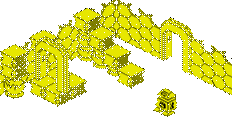Sega Saturn
Vital Statistics
Introduced
22nd November 1994 (Japan), 11th May 1995 (USA), 8th July 1995 (Europe)
|
|
![]()
What's it like today?
|
SEGA's Saturn project started in 1992 following hot on the heels of their Model 1 arcade system which successfully showcased their move into 3D gaming technology. In early 1994, the hardware market was starting to look crowded, with knowledge that Atari was preparing a 1994 launch of their new Jaguar console as well as Sony with the PlayStation. Due to this market pressure, SEGA's engineers were ordered to complete the Saturn project by the end of 1994. In fact the Saturn's design was largely finished at this point, but reports of the PlayStation's forthcoming technical capabilities prompted SEGA to include a second video display processor (VDP) to improve Saturn's 2D performance and texture-mapping.
In parallel with the Saturn development, SEGA were also working on an add-on for the Mega Drive/Genesis, called 32X. This would be pitched at Mega Drive owners who could not afford the higher-priced Saturn, and would extend the life of the Mega Drive by adding 32-bit performance. Some advantages of this parallel development were that both shared a similar architecture with the use of a Hitachi SH-2 RISC chip at their core. This enabled some knowledge-sharing within SEGA of how to develop titles for the SH-2. Unfortunately, again due to market pressures to release as quickly as possible, development of the 32X was rushed, cutting into precious time needed for games developers to complete new 32X titles. With few launch titles, sales were very poor despite the retail price being half what the Saturn's would eventually be, especially after the holiday season was over. This left retailers with large quantities of 32X stock they couldn't sell.
The Saturn was a powerhouse of a console, featuring eight processors - two Hitachi SH-2 CPUs, two VDPs (one for backgrounds and a second for textures, sprites and polygons), a Motorola 68000 for sound, a custom sound processor called SCSP, a Hitachi SH-1 for driving the CD-ROM, and the SCU - System Control Unit which acts as a bus controller and coprocessor for the main SH-2 CPU. All this resulted in potentially better performance than its main Sony rival, but Saturn was more difficult to develop for, where released titles perhaps weren't utilising the full power of the Saturn.
Saturn was launched in Japan in November 1994 as planned, for 44,800 Yen, with just a few launch titles available. However, sales were initially strong, outstripping PlayStation sales (PS was launched on 3rd December in Japan). By the end of 1994, SEGA had sold 500,000 Saturns whilst Sony had sold 300,000 PlayStations. Throughout 1995, Sony began to overtake SEGA in Japanese sales, primarily due to a larger number of titles being made available. Sony had attracted many third-party developers to the PlayStation with a low licencing fee and great development tools.
Within SEGA of America, preparations were underway for the U.S. launch of Saturn. Announced as 2nd September 1995, this was brought forward to May 11th by a mandate from SEGA of Japan in order to beat Sony to a U.S. launch and hopefully establish an early lead in the North American market. This early launch upset retailers who were already feeling the pain from poor 32X sales, and some even dropped SEGA from their lineup as a result. At the same time, Sony made a surprise announcement that PlayStation would be sold for just $299 USD. This was $100 cheaper than Saturn.
At the time of launch, Saturn had just six titles, as the rest had been slated for the originally planned [later] launch date of September 1995. By the September date, just two more titles had been released for the Saturn. Sales were understandably lacklustre, to the point that Sony PlayStation overtook Saturn's five months of sales after just 2 days of PlayStation's launch. A similar situation occurred in Europe, where the Saturn launch was unexpectedly brought forward with retailers and press having no time to promote the system. The UK launch price was £399. By November 1995, PlayStation sales were three times Saturn's. Some of Sony's successes were down a much larger advertising budget than SEGA's. Back in the U.S. by the end of 1995, 400,000 Saturn units had been shipped that year, compared to 800,000 PlayStation units.
Later on, an updated model in a recolored light gray (officially white) went on sale in Japan at a price of 20,000 Yen. Other accessories were available, including a multi-tap for up to 6-player gameplay on a single Saturn, wireless controllers, a lightgun called "Virtua Gun" and the "Arcade Racer" steering wheel.
Saturn was retired in 1998 by SEGA of America and Europe, but sales continued in Japan until 2000.











